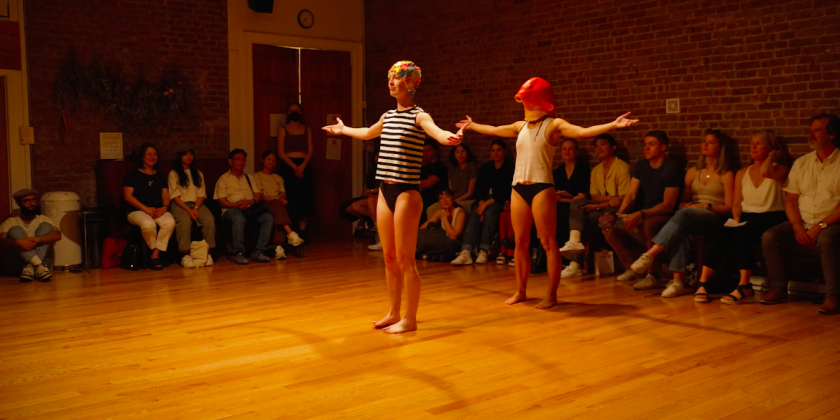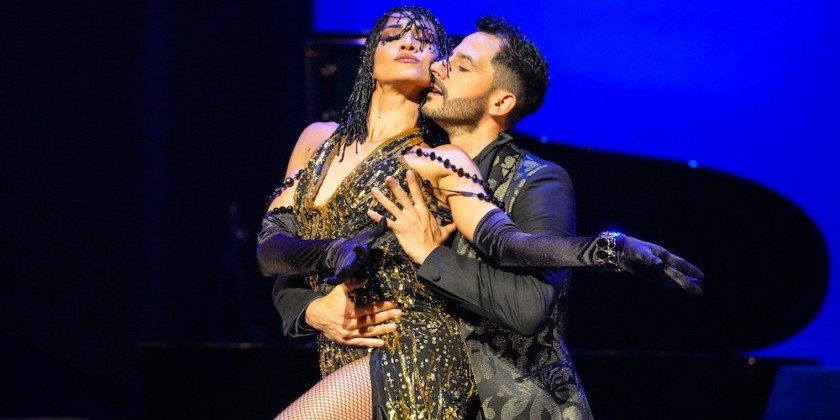AUDIENCE REVIEW: A Night of Pride, Community, and Exploration

Company:
7 Midnights Physical Research
Performance Date:
June 2nd 2024
Freeform Review:
Entering a performance space like Studio 3F at Arts on Site as audience members mingle and find seats along the thin benches that line all four walls quickly becomes an intimate act. The audience squeezes together, bending torsos and turning heads to say hello to an old friend or to make a new one. While some audience members hold flowers for performing loved ones, there are many, like myself, who have come to the performance of Seventh Midnight to witness, to watch, and to listen.
7 Midnights Physical Research (7MPR), founded by Jiali Wang, offers a performance platform for emerging artists in New York City to present choreographic pieces that explore one or more entangled sociological topics: gender, sexuality, race, class, education, age, and ability. This particular performance, held on June 2nd, was their Pride Month Celebration.
As the lights dimmed, founder Jiali Wang entered the space and began to introduce the evening's performance. As they spoke, their body rippled and reacted in harmony with their words and moved with their intonation. As Jiali swung and lept through the space, a clear environment was immediately established to usher attendees into the night to come.
Following Jiali’s introduction was “Slippin” by Danna Creager of the Breath Dance Project. The quintet of dancers (Phoebe Amory, Danna Creager, Shohini Gupta, Rachel Lovett, Emma Lower) explored themes of gender and sexuality. Contrasted moments of stillness are coupled with moments of touch, instigated movements oscillated between moments of loneliness and moments of grounding and strength. The repetition of reaching and extending to the music of Omar Apollo created a mesmerizing opening piece that left the audience in a daze as it ended.
“Eugene”, choreographed and performed by Bailey Fleming, accompanied by the Arlo Parks song of the same name, presented the audience with a dancer donned in a black jacket who's struggled to find their groove. Hesitation guided their movement as they flowed in and out of the steady rhythm of the song. The piece reminded me of the struggle to remain in moments of comfort and community, and displayed immense vulnerability in letting the audience be privy to such an experience.
In a duet choreographed and performed by Zazel-Chavah O’Garra and Wendy Ann Powell of ZCO/DANCEPROJECT titled “Recovery”, the women explored race, age, disability and ability through differing dynamics of movement, vocalizations, and incorporation of both a cloth and a chair. The two women built their connection through conversation of movement and palpable support for each other's slowing bodies.
A second duet titled “As We Quiet Ourselves” choreographed by Jessica Hutchins featured two dancers (Taylor Dukeman and Jessica Hutchins) one in a tank top and the other in a button down. The dancers oscillated between varied dynamics, when one performed the movement fast and full out, the other performed a slow and marked version of the movement. It appeared as if the pair were a mirror of each other; they are separate but same as they explored facets of gender limitations and freedoms. By the end of the piece there was a sense that these two parts had made each other whole.
The final piece before the intermission was choreographed and performed by Melinda Harrison and Rylan Joenk. “Pearl (a duo exploration of PEARL DIVER)” brought a sense of absurdity and camp to its investigation of gender and sexuality. The first dancer is identified as the Swimmer through their floral vintage bathing cap. The Swimmer is then joined by the second dancer, the Fish, who is dressed similarly, however their face is covered with a large rubber fish head mask. The pair engaged in a one sided dance battle instigated by the Swimmer. The repetitive movement made me wonder if the intention was to show off to the fish or rather to engage in a specific ritual. The piece encouraged laughs from the audience and was a big crowd pleaser.
The first piece following the intermission, “i used to hate myself but (maybe) i don’t anymore” choreographed and performed by Gwen Appenfeller used mixed media including projected home videos and voice over quotes from trans icons like Marsha P. Johnson and Sylvia Rivera in tandem with choreography in a moving examination of transness and the challenges that arise when pulling from the traditional binary. Appenfeller’s movements ranged from stillness as they watched their younger self dressed as Tinker Bell to erratic convulsions on the floor. It appeared as though they were figuring out how to use their body, how to smile, how to cry, how to relax. At a certain point it appeared as though they could hardly stand, their body was so foreign to them. The ending of the piece offered a sense of reconciliation as Appenfeller watches their younger self in a childhood dance concert.
“Renters Insurance” was choreographed by Magali Johnston-Viens full of shifting dynamics as three dancers (Ava Desiderio, Olivia Mitchell, and Sophie Herron) move through traditional ballet and classic modern to the music and otherworldly sounds of Aphex Twin. The trio break from their shifting dynamics to present a birthday celebration as the three put on pointed birthday hats and gather together. While they mimic a celebration, the dynamic between the three dancers is stilted and uncomfortable as a voicemail recording interrupts the ambient noise. Just as they had stopped their dancing, they began again with a balletic language before the piece came to an end. The piece was beautiful and at times unsettling in its sometimes apathetic whimsy.
The next piece, “Riven”, a duet choreographed by Chris Johnson of Chris Johnson Dance, felt like an intimate and flowing conversation between the two dancers (Jasmin Davis and Alessia Palanti). Each touch created a reaction in the other, no matter how small. There was a feeling that there was no right and wrong, and that each movement was complimentary to the next. The choreography felt well worked and the chemistry between the dancers and their relationship to the movement left me and the people around me speechless as it ended.
The final piece of the night was titled “The Stranger” and was choreographed by Yang Sun. The quartet (Alisya Razman, Angelica Maria Barbosa Rodriguez, Yang Sun, and Alexis Vinzons) entered the space carrying large plastic woven grocery bags. As two dancers engaged in a duet, a third looked on in an apparent struggle to understand and join into the movement. The dancers took turns falling to the ground and later on one dancer began to whip her head around as her hair slowly fell out of the brain in reaction to her movement. The same dancer moved alone as she rebraided, the action of making and unmaking. As the dancers moved together and apart, I got the sense that the dancers were finding and leaving community. As the piece continued, the dancers moved as a community supporting and pulling each other back into the group. The piece was a stunning conclusion to the evening and reminded me that above all things, community is often the most life changing.
To close out the night, Jiali Wang returned to the space as drums played by Michael Glanzer filled the room. Dancers and choreographers joined her as they all danced along to the music, and pulled different members of the crowd to form a large dance party celebration of the night's success. The feeling in the room was electric as the performers melted into the audience as they were united as one community. I greatly enjoyed my evening with 7MPR and I am deeply excited to witness their next performance.
Author:
Claire Goldberger












